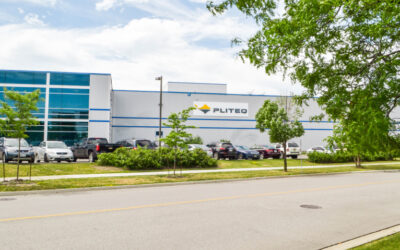The markets for paint and sealants have had a tumultuous time as of late, due to “the COVID-19 pandemic, raw material shortages and supply chain disruptions,” states the American Coatings Association (ACA). The ACA is a trade group for the paint and coating industry, but their words apply to the sealant sector as well.
At the same time, COVID also led to a surge of interest in do-it-yourself (DIY) home renovation projects, online shopping, and eco-friendly/germ-terminating products within the paint and sealant sectors.
Both sectors, but particularly the paint market, are huge. The U.S. paint and coatings sector employed over 300,000 people in 2021, with roughly 42,000 directly working in paint and coating manufacturing, according to the ACA. That same year, product shipments from paint and coating producers reached nearly $30 billion.
“Architectural coatings”—that is, paints and coatings used both indoors and outdoors on commercial and residential buildings—represent the largest portion of the industry. Applied on everything from drywall to brick, wood, concrete block, metal, stucco, and beyond, such paints account for half the value and 60 percent of the volume of the U.S. paint/coatings market.
“The total volume of architectural coatings is estimated at approximately 900 million gallons for 2021. Roughly two-thirds of the total volume is applied in interior spaces and waterborne latex is the dominant technology. About 85 percent of the interior coatings are waterborne,” states the ACA.
Prior to COVID, professional painters handled roughly 60 to 65 percent of painting jobs in the U.S., states the ACA. When the virus hit, offices and commercial and recreational sites went into lockdown mode, and painters found themselves shut out of work. To an extent, homebound consumers coping with the same lockdowns picked up the slack. “Paint applications by DIYers increased in 2020 to an approximately 44 percent share,” notes the ACA.
And DIYers embarking on home renovation projects weren’t always buying their paint in-person. “The pandemic has accelerated the incorporation of online shopping for architectural paint… Homeowners are now able to start a project from the comfort of their home online, then visit the local paint store to pick up their paint and supplies from their online order,” stated Daniel Claybaugh, Vice President of Marketing and Business Development for Kelly-Moore Paints, in an industry roundtable hosted by CoatingsTech Magazine, an ACA journal.
Online paint sales are still dwarfed by sales at brick-and-mortar retail locations, but continue to grow each year, adds Claybaugh.
During the same roundtable discussion, Kyle Mooney, Product Management Director for Architectural Coatings for PPG, noted that professional painters (whose services began rising in demand in 2021, said the ACA), have also recognized the utility of online shopping. “In the next three years it is estimated that professional painters will make more than half of their purchases online, seeking faster, more cost-effective ways to purchase products,” stated Mooney, citing a study by PPG and a research firm.
For professionals, buying paint and related products online streamlines the purchase process while saving valuable time.
The paint and coatings industry has also responded to growing concerns about health and the spread of germs. “Another outcome of COVID is the increased demand for antimicrobial coatings,” notes The Farnsworth Group, a research firm in Indianapolis, Indiana.
While not a new concept, antibacterial and antimicrobial paint is ideally suited for an environment in which disease prevention has taken on a new urgency.
The Behr paint company, for example, has introduced Behr Copper Force Paint, which was tested and registered with the U.S. Environmental Protection Agency (EPA). Copper Force Paint can kill a variety of viruses and bacteria “within two hours of contact on the painted surface” and its effect lasts for years if the paint is properly applied, according to Behr literature.
Viruses and bacteria targeted by Copper Force Paint include SARS-CoV-2 (the virus responsible for causing COVID, according to the Centers for Disease Control and Prevention), Staphylococcus aureus (commonly known as Staph), and human noroviruses. That said, Behr’s bacteria-killing paint should only be used on walls, trim, ceilings, and doors, and not on floors, outdoor spaces, or “any portion of an operating room, which undergoes more stringent cleaning protocols,” notes the company.
In a similar fashion, paint manufacturers are embracing “green” products derived from plants, with minimal VOC content. Within the paint and coatings industry, volatile organic compounds (VOCs) are commonly used as thinners or solvents to enhance the properties of resin for better performance, durability, and appearance. VOCs are also pollutants, however, that are not good for the environment.
“Most waterborne paint resins are derivatives of petroleum and natural gas,” noted Derek Ward, Vice President of Operations for Farrell-Calhoun Paints, during the CoatingsTech roundtable. Bio-paints are continuing to enter the market, however, and Ward noted the presence of “waterborne alkyd emulsions based on oils such as soybean that are derived from a renewable source and are used in some trim enamels.”
The Royal DSM company has also been a leader on the bio-based/low-VOC front. Up to half of the company’s Decovery resin (launched prior to COVID) contains “plant-based content, such as seeds, tree bark, corn, and castor beans,” reported a July 2018 article in Coatings World magazine. This bio-based resin has a carbon footprint one third smaller than its oil-based acrylic resin counterpart, while offering equally good performance and negligible VOCs.
COVID had another interesting impact as well—on interior design choices.
“During difficult inflection points throughout history, we often see consumers gravitate toward more colourful selections, as previously seen during the Roaring Twenties or after the Great Depression. As part of this cyclical history, PPG is seeing a post-pandemic optimism start to infiltrate residential design spaces to create a sense of escapism. Just as trends in the 1920s were marked by opulence, metallics, rich woods, layers, moody colours, and angular shapes, today’s home décor is drawing inspiration from the Antiquity, Baroque, and Renaissance eras of art, sculpture and architectural forms,” said Mooney in the industry roundtable.
The sealant market has also been coping with COVID, among other issues.
Sealants are used to create a barrier to prevent water, chemicals, dust, or dirt from seeping into a wall, window, or other space. There are multiple varieties of sealant, including acrylic, oil-based, polysulfide, butyl, silicone, polyurethane, and more. At present, the sealant and adhesive industry in North America is worth $22 billion and employs nearly 30,000 people, states the Adhesive and Sealant Council (ASC).
“Adhesives and sealants are used in every major market for their versatility, cost-effectiveness, product design flexibility, and incredible strength and durability,” notes the ACS, a non-profit group founded in 1958. These markets include the transportation, consumer/DIY, construction, and assembly sectors.
At the peak of the COVID crisis, trade publication Adhesives & Sealants Industry questioned industry experts about the state of the sector (just like CoatingsTech did). Participants expressed concerns about raw material shortages, supply chain woes, and rises in shipping costs. Their views were published by the magazine in early 2022.
Pundits noted that demand for sealants collapsed in North America in the first half of 2020, then sprang back to life, propelled by consumers (doing home renovations and such). However, there wasn’t enough sealant supply to meet the surge in demand.
Challenges with logistics wreaked havoc on delivery schedules and lengthened lead times, particularly on materials shipped across the Pacific Ocean: “Nearly 40 percent of the world’s chemicals are sourced from China, and most companies in the adhesives and sealant industry are being impacted to some degree,” said Rob Hubbard, Vice President Global Strategic Sourcing for H.B. Fuller.
Silicone sealants were “the most affected material” as “the capacities are highly concentrated in Asia,” added Bjorn Neal Kirchner, Corporate Vice President Global Supply Chain for Henkel Adhesive Technologies.
“The tightness in raw materials has impacted pretty much every end-use sector in adhesives and sealants. The challenges in logistics, port congestion, and driver shortages have impacted us all,” voiced a third roundtable participant, Julie Vaughn, Global Business Development Director for Emerald Kalama Chemical, LLC, now part of Lanxess. In February 2021, Winter Storm Uri crippled much of Texas, and a few months later, Hurricane Ida slammed into Louisiana and other areas. Petrochemical facilities in these states were battered, which in turn disrupted the sealant industry.
Like their counterparts in the paint and coatings industry, sealant companies are also looking for eco-friendly alternatives. To this end, DOW Chemical offers a product line of carbon-neutral silicones “for more sustainable building façades.” Products in the company’s carbon-neutral DOWSIL sealant line are used for insulating glass, weather sealing, and structural glazing.
The company also launched “the first-ever carbon-neutrality service—available for silicones used in structural glazing, insulating glass, and weather sealing applications on high-performance building facades,” as DOW literature puts it.
Building designers or architects can arrange to have the company apply its Dow Carbon-Neutral Silicone Service for Building Façades on projects that incorporate carbon-neutral silicones from Dow. The service entails Life Cycle Analyses, external CO2 audits, and Environmental Product Declarations for the growing number of firms interested in going green—just one more way this evolving industry continues to shake things up.













